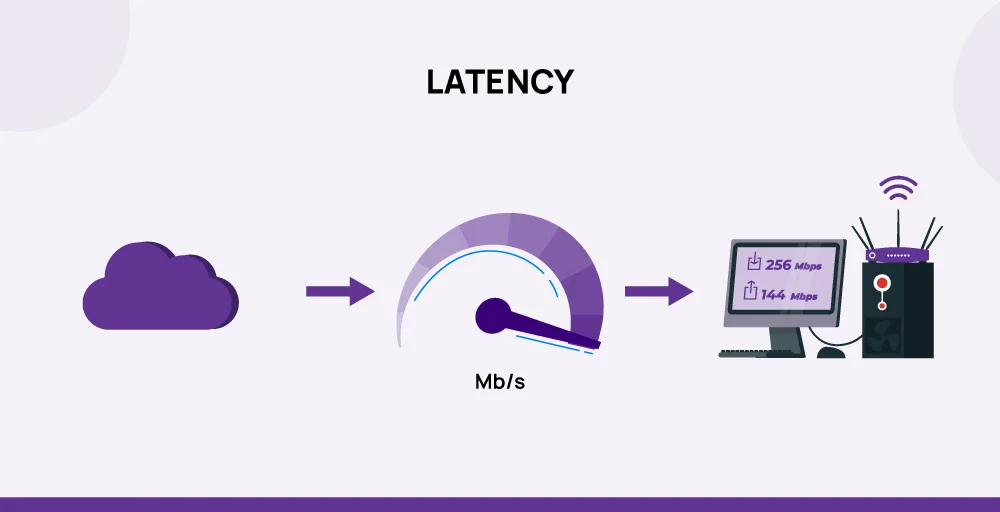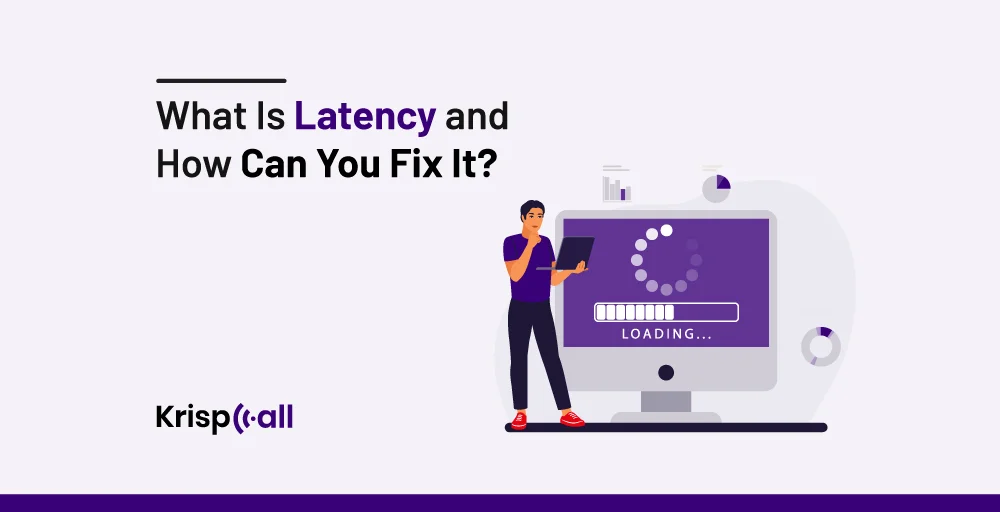Latency is an essential parameter in technology, closely linked to the definition of efficient working systems and applications. Latency does not have to be an issue all the time; examples of acceptable latency include web browsing and email.
However, it becomes very stressful when dealing with real-time applications such as game playing, video conferencing, or VoIP calls. High latency had the negative impact of the loss of connection, increased connection time, and a very understandable frustration from the user space perspective end.
In this blog, we will decode latency, its various forms, the factors that contribute to it, the consequences it entails, and, last but most importantly, what can be done to address it. We will also discuss the problems connected to latency and how to resolve them.
🔐 KEY HIGHLIGHTS
- Latency is the delay between an action/request and the corresponding response/effect; mainly caused by various factors, such as network congestion, hardware performance, and transmission medium.
- Low latency is essential for better user experience, productivity, competitive advantage, and IoT systems, making its applications responsive.
- Common types of latency include interrupt, fiber optic, network, processing, rendering, and VoIP latency.
- CDNs, optimizing routing, enabling compression, edge computing, persistent connections, caching, and monitoring performance are ways to reduce latency.
- Streaming, gaming, and video calling all require low latency, which is under 100ms; real-time apps require under 50ms.
What is Latency?

Latency measures the time it takes for data to move between network nodes, which is the delay in the information transfer process. If it takes time for information delivered over a network to get from source to destination, then the network has high latency; when the response time is quick, the network has low latency.
Lower latency is preferred for better throughput and business automation, especially across selective industry verticals and use cases, including streaming data processes, real-time data processing, API M. integrations, and video-driven remote processes or control.
Some of the factors that cause network latency are the mode of network transmission, the distance across which the network traffic travels, the number of network intersections, the size of data passed across the network, and the server’s ability. Several metrics, such as TTI (Time to First Byte) and RTT (Round Trip Time), can be used to compute network latency.
Types of Latency
There are many types of latency, each of which comes from a completely different group and has different definitions. To familiarize you with some of the most common ones, here are a few:
1. Interrupt Latency
Interrupt latency can be defined as the delay experienced in a computer system before an acceptable host operating system responds to a signal. This indicates that the host OS should stay idle until a decision can be reached regarding which action should be taken regarding an event.
2. Fiber Optic Latency
Fiber optic latency is how long light travels a specified distance through a fiber optic cable. It is often calculated based on the speed of light. For every kilometer covered, a latency of 4.9 microseconds occurs.
3. Network Latency
Network latency or lag time refers to slow data transfer between your device and the server. This latency can be attributed to the physical distance between two devices, the type of network being used (wired or wireless), and the network congestion level.
4. Processing Latency
Processing latency is a term that shows how long processing servers should take to receive a request and generate a response. Bandwidth, processing time, and database management are the aspects that determine this kind of latency.
5. Rendering Latency
Rendering latency, or frame rate lag, manifests when information is processed into a form the user can see on their device. Some of these are the graphics processing capabilities, the screen refresh rate, and how well the software is optimized.
6. VoIP Latency
It is common knowledge that VoIP calls work through the transmission of data packets. In that context, VoIP latency is the delay between when a voice packet is transmitted and when it reaches its destination in a Voice over IP (VoIP) system. Typical VoIP latency is around 20 milliseconds.
Why is Low Network Latency Important?
Network latency is the perceived time delay in data transfer across devices connected via a digital content network. The notion of low latency is important today because globalization has made everything fast-paced.
Let’s discuss why low latency is essential in all aspects.
1. Enhances User Experience
People may become unwilling to wait for the slow download of information and then be unable to participate in activities such as playing on the Internet, using video calls, or watching live broadcasts. High latency is undesirable because it makes the delivery of certain services take longer and incites additional irritation and annoyance from users.
2. Improves Productivity
In the context of companies that deal with higher levels of operation productivity depends on network latency. Poor and slow internet connections may lead to delays in accessing necessary information and transacting finances, further causing a delay in the project timelines, all of which may lead to reduced production or loss of revenue.
3. Gives Competitive Advantage
Different centers that provide the same services and are vying for the same clients need to pay more attention to how fast they respond to clients and the reliability of their services. In the e-commerce and entertainment market and companies offering various financial services, such as PayPal, today, the speed of your network is the biggest weapon that can help you win and retain customers.
4. Better Connection in IoT Devices
Low latency is a positive aspect of IoT devices. It connects to smart appliances, wearable devices, and industrial sensors, allowing millions of connected devices to make conversation and communication. High latency levels on the network can cause a jitter that can distort data from one point to another and reduce the efficiency of IoT systems.
What are the Causes of Network Latency?

Network delays or the execution time before data transfer begins relative to an instruction can be significantly impacted by several items. It is essential for latency problems to be identified and eliminated, and this can only be achieved if we understand the causes of such issues.
Here are the primary causes:
1. Distance
This guarantees that the physical distance separating the source and destination of data directly correlates with latencies. The delays further increase as the data have to move across a longer distance. This is because every signal transmission has its speed, which it takes in the transmission process in the transmission medium, such as fiber optic cables, copper wires, or wireless transmission media.
2. Network Congestion
This means congestion results when many devices are active on the network, or in other words, are sending or receiving data through the network. Data packets reside within stimulated queues amid traffic congestion before they are processed and forwarded. Although this queuing delay is beneficial in that it facilitates proper alignment and sorting of packets for onward transmission, it increases the total latency.
3. Hardware Limitations
Handling the request may take longer due to older or less efficient networking hardware like routers, switches, or modems. These devices must search, switch, and forward data packets, and if they are slow, this can be a problem.
👍 You may also like Best VoIP Routers For Your Business
4. Routing and Switching
The delays incurred can be attributed to the route that data packets follow within the network. Every route change (or hop) incurs additional delay since each hop’s function requires some amount of processing. Multi-hop connections, therefore, imply increased latency.
As mentioned earlier, using more routers in a path implies delay due to the time it takes for a datagram to go through all the routers to reach its final destination.
5. Propagation Delay
Propagation delay is defined as the time it takes from the signal being transmitted to the time it is received by the intended recipient. This delay depends on the transmission medium and the distance the signal has to travel through the physical medium.
It still takes time, however small, for light to travel this distance, and this delay can be perceived when one is traveling at the speed of light over such a distance.
6. Transmission Delay
Transmission delay occurs when pushing all the bits of the packet on a wire. This is likely to be determined by the packet size and the bandwidth of the network link in place. The above equations suggest that higher bandwidth and smaller packet sizes tend to minimize transmission delays.
7. Network Latency, Throughput, and Bandwidth
Latency, bandwidth, and throughput, often used to describe networking concepts, often overlap but are somewhat different. Bandwidth means the rate at which data can be processed simultaneously in a network.
Unlike utilization, whereby the average rate at which the system is being utilized is evaluated, throughput relates to the average amount of data successfully transferred over a given time. It is important to note that throughput is not always equal to bandwidth because it is reduced by latency and other factors that affect throughput but have no impact on bandwidth.
One more metric used to describe a network is network latency, which denotes time units and is a delay value for data transfer independent of the quantity of transferred data.
Impact of Network Latency
Network latency significantly influences network performance, often manifesting in multiple ways:
- Slow Response Time: When the latency is high, the application or tool takes time to return a command or result, which is unsuitable for activities such as video conferencing or gaming since it hampers user experiences.
- Reduced Throughput: This results in high latency and low throughput, meaning data is transferred at a slower-than-desirable rate. This is problematic when dealing with applications that require large amounts of data as well as with services where performance is desired.
- Increased Buffering: It is, therefore, worse in terms of quality and buffering because high network latency responds slowly to requests from video streaming services, which causes viewers to lose their patience and quit using the service.
- Lower Efficiency: This impacts network communication in that it delays overall data communication and limits the network’s capacity to accommodate high traffic at any given time.
- Impaired Cloud Services: A huge amount of delay in cloud applications slows down the accessibility to data and applications that bring more Halo to business processes.
Network sensitivity is faced by network-sensitive applications that undertake VoIP, video streaming, and online gaming, which are affected by network latency. Any such delay can harm the call quality, streams, or gameplay to the point where they represent an inconvenience for consumers, which is a sure way of driving customers away.
How can you Measure the Network Latency?
Network performance measurement tools, such as TTFB or RTT, which are important for network monitoring and testing, can help approach the concept of network latency. Some ways that you can use to measure network latency are:
1. Time to First Byte
Time to First Byte (TTFB) records the time it takes for the first byte of data to reach the client from the server after the connection is established. TTFB depends on two factors:
- The time the web server takes to process the request and create a response.
- The time the response takes to return to the client.
TTFB = Server Processing Time + Network Lag
Perceived TTFB = Actual TTFB + Client Processing Time
Thus, TTFB measures both server processing time and network lag.
You can also measure latency as perceived TTFB, which is longer than actual TTFB because of how long the client machine takes to process the response further.
2. Round Trip Time
RTT measures how long it takes the client to send a request and receive the server’s reply. Network latency increases round-trip delays, which raises RTT. Nevertheless, RTT estimations from the network’s surveillance tools do not provide complete information because data may travel through various network routes throughout the client-server communication.
RTT = Time to send request + Time for server response
3. Ping Command
The ping command measures how long it takes for 32 bytes of data to be transmitted to the destination and for the network administrator to receive an acknowledgment. It helps evaluate the reliability of connections, but it cannot analyze the relation of several paths at a time from a command center or address latency issues successfully.
Ping Time = Time to send 32 bytes of data + Time to receive an acknowledgment
How to Reduce Latency?

Reducing latency includes implementing diverse strategies to optimize the community’s overall performance. Here’s a list of a combined set of steps that you can take to reduce latency:
1. Utilize Content Delivery Networks (CDNs): Leverage CDNs like Cloudflare or Amazon CloudFront to cache content in the direction of end-users, reducing the space information wishes to travel and, therefore, decreasing latency.
2. Optimize routing: Implement innovative routing strategies supplied via AWS Route fifty-three or Cloudflare Argo to ensure that data takes the maximum efficient course between the patron and server, minimizing latency.
3. Enable Compression: Compress facts before transmission using features like Cloudflare’s Brotli compression or AWS’s Content-Encoding, reducing the dimensions of records packets and accelerating transfer instances.
4. Leverage Edge Computing: Deploy compute assets to give up-customers the usage of AWS Lambda@Edge or Cloudflare Workers to process requests domestically, reducing spherical-ride times and enhancing reaction times.
5. Use Persistent Connections: Keep connections between the consumer and server for longer intervals to avoid the overhead of setting up new connections for each request, enhancing performance and reducing latency.
6. Optimize TLS Handshakes: Minimize the time spent on TLS handshakes by configuring consultation resumption and using modern-day TLS versions, enhancing the rate of stable connections.
7. Implement Caching: Cache often accessed statistics at the edge using Cloudflare’s caching functions or AWS’s Elastic Cache to serve content fast without fetching it from the origin server, lowering latency for subsequent requests.
8. Monitor and Analyze Performance: Use monitoring tools like AWS CloudWatch or Cloudflare Analytics to track latency metrics and perceive bottlenecks, permitting proactive optimization of community overall performance.
By following those steps and leveraging the abilities of each Cloudflare and AWS, groups can successfully lessen latency and enhance the responsiveness in their community infrastructure.
Conclusion
While latency (low or high) is a critical component in the performance and operations of any network, it significantly defines the syntax of the network in terms of user and application interactions. Policies should be implemented to minimize latency using strategies related to network routing, CDNs, data compression, and edge computing.
Latency mitigation enhances the operational efficiency of the underlying network infrastructure, the customer experience, and the overall performance of digital business initiatives. Also, remember, proactive monitoring and optimization strategies can be recommended as the basic method for ensuring the effective functioning of the network at the highest possible rate.
FAQs
What is a good latency pace?
Latency speeds under 100 milliseconds (ms) are appropriate for maximum packages. And, for real-time applications like online gaming or VoIP calls, lower latency speeds, preferably below 50 ms, are perfect to ensure clean and responsive reports. However, a proper latency velocity depends on the precise software and user necessities.
What is the latency of a system?
A system’s latency refers to the time delay between an action and its corresponding reaction in a system. It encompasses different factors, such as processing time, community transit time, and additional delays from gadget components or configurations.
What are the applications that need low network latency?
Applications that require low community latency include real-time conversation gear like video conferencing, VoIP services, online gaming structures, high-frequency trading systems, and live streaming services. These programs depend on instantaneous responsiveness and minimal delays to provide seamless user reviews.
Is high latency better?
High latency is not better, particularly for services requiring real-time interaction or fast response times. High latency can cause delays, buffering, and a poor user experience, especially in online gaming, video streaming, and VoIP calls.
How does latency affect network performance?
Latency impacts the network’s overall performance by introducing delays in information transmission and conversation between gadgets. High latency can bring about slower reaction instances, increased buffering, and reduced throughput, ultimately impacting person satisfaction and application reliability.
What does low latency mean?
Low latency refers to minimal delays in data transmission and conversation within a community. It suggests that record packets journey quickly between source and vacation spot, resulting in faster reaction instances and overall performance for actual-time packages.





